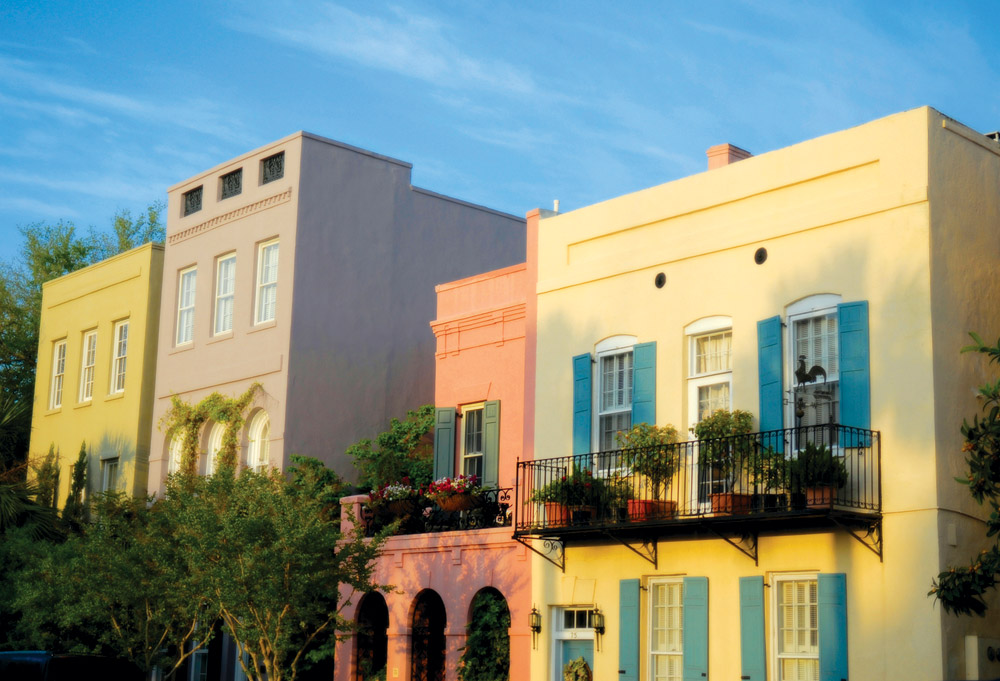Think of America’s most significant cities and names like New York, Los Angeles, Boston, and Miami probably come to mind. Packed with skyscrapers—beacons of commerce and business—prestigious universities, world-class medical facilities, busy ports, and bustling arts, culture, and culinary scenes, not to mention millions of residents, these metropolises are hotbeds of American progression. But on a sleepy peninsula bordered by the Ashley and Cooper Rivers and with nary a glass tower in sight, Charleston, SC., bears as much significance as any of those cities thanks to its 300 year old history and the vigor with which it’s preserved.
On a walk, bike or carriage ride, or drive through the grid of Charleston’s streets—lined with sturdy palmettos, meticulously kept antebellum mansions, and English-style gardens—the city could easily be a neatly preserved historical site like Colonial Williamsburg in Virginia or Abraham Lincoln’s Springfield, IL, neighborhood. On the contrary, Charleston is very much a livable and exciting city, where centuries-old architecture and historical sites remind residents and visitors of its past while technology, arts, education, and a booming culinary scene propel it toward a bright and beaming future.
Settled in 1680 by English colonists on land granted by King Charles II, the then-named Charles Town became a key sea port. By the early 19th century, Charleston was among the New World’s most fashionable cities, second only to New York in importance. During that period, clipper ships brought exotic cargo from China, Europe, and the West Indies, for which merchants traded items like indigo and Carolina Gold rice and cotton. In April 1861, Charleston entered into a new chapter of American history when Confederate soldiers fired on Fort Sumter in Charleston Harbor, marking the start of the Civil War. After the war and throughout the mid-1900s Charleston was short on capital, a condition that slowed its post-war recovery, but that would also prove serendipitous. Instead of razing then reconstructing its buildings, the city kept its structures intact; today, those preserved and restored homes and municipal buildings set Charleston apart as one of the most historically significant cities in the United States.
Today, every turn through the city’s streets presents photo-worthy views of antebellum homes, built in Georgian, Greek Revival, Victorian, and Federal styles. Rightly so, one of the city’s most popular—and photographed—tourist draws is Rainbow Row, a stretch of East Bay Street lined with pastel-colored row homes. The Battery area, on the peninsula’s southern tip, presents ample opportunities for viewing more of the city’s stunning signature homes.
In addition to its homes, important architecture is on display in Charleston’s churches (the number of houses of worship here earned the city the nickname The Holy City) and even in the retail stores that line King Street, many of which used to be banks or old theaters.
Whether you’re sitting down to supper at one of Charleston’s highly-regarded restaurants, collecting designer-label shopping bags on King Street, or exploring a treasure-filled historic home on Meeting Street, locals and visitors can revel in the city’s contemporary offerings while reliving its treasured history—next to no imagination required, charlestoncvb.com.
PERFECTLY IN PLACE
The beautiful Charleston Place hotel puts guests in the center of the city’s charms.
Visitors wanting to stay within easy reach of downtown Charleston’s museums, historic sites, restaurants, and shops would be hard pressed to find a better choice than Charleston Place Hotel. Located between Meeting, Market, and King Streets, the elegant, 435-room Orient-Express property provides front-and-center access to Charleston’s key attractions and is situated atop a luxe shopping plaza housing Louis Vuitton and St. John boutiques, among others. But Charleston Place also offers a world of high-level options all its own, from guest rooms and suites to restaurants and spa services.
Accommodations comprise deluxe rooms and spacious suites, with a private-access Club Level offering guests exclusive concierge services and the added advantage of a lounge to enjoy breakfast, afternoon tea, evening cocktails and hors d’oeuvres. Rooms and suites feature soft, neutral décor with traditional floral accents, plus amenities like king-size beds, Italian-marble bathrooms, and large windows that open to views of the city.
Charleston is rife with hot-ticket restaurants, and Charleston Place Hotel is home to two of them. In the light-filled Palmetto Café, in which oversized windows give way to views of a blooming courtyard, guests can enjoy modern American Lowcountry fare for breakfast, lunch, and Sunday brunch. For dinner, the AAA Four Diamond-rated Charleston Grill is the jewel in the hotel’s culinary crown. Chef Michelle Weaver has steadily been gaining recognition in industry circles for her innovative approach to local delicacies, her dishes bursting with the flavors of only the freshest ingredients.
Take the Thai Fish entrée, for example, which wait staff serve with a spoon so diners don’t miss a drop of the delicious broth infused with pineapple, cherry tomato, and basil. Knowledgeable staff and sommeliers are at the ready to help patrons choose well-paired labels from the restaurant’s award-winning wine list.
Charleston is a walking city, and nothing combats aching feet better than a visit to the hotel’s excellent spa. Services include traditional massages, facials, and body treatments, but when in Rome (or, in this case, Charleston) do as Southerners do and opt for something more Charlestonian like a skin reviving like a Magnolia Blossom Body Scrub. The spa’s serene atmosphere will likely lead to multiple visits—just as the city of Charleston is sure to lure visitors time and again, charlestonplace.com.


